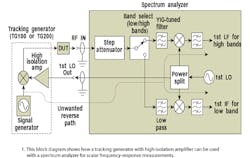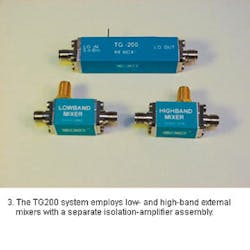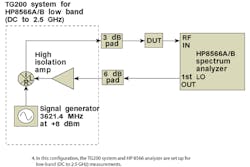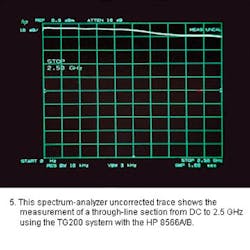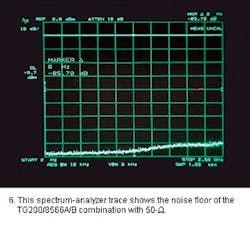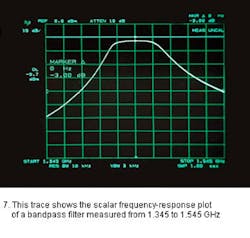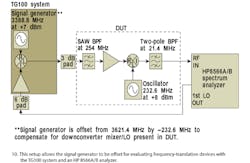Tracking Generators Enhance Spectrum Analysis
This file type includes high resolution graphics and schematics when applicable.
Spectrum analyzers have long been used with tracking generators to perform swept scalar frequency-response measurements on active and passive networks. While many commercial spectrum analyzers can be specified with optional tracking generators, most of these sources only provide a signal for the first band of the analyzer. The method that follows will also cover the first high band of many spectrum analyzers. A method will also be presented that allows sweeping a device under test (DUT) with internal frequency conversion.
Figure 1 shows a common RF spectrum analyze architecture with the tracking generator function implemented with a mixer, amplifier, and RF signal generator set to a fixed first intermediate frequency (IF). This approach works provided that the analyzer sweeps only the first local oscillator (LO) to achieve the frequency scan. Also, the analyzer must provide a sample output of the first LO. If the analyzer's resolution-bandwidth (RBW) filters (whether analog or digital) are fixed and only the first LO is swept, then this configuration will produce the correct signal.
In this setup, the signal generator is set to the first IF of the band of interest (which can be found from the analyzer manufacturer's data or by experimentation). The first IF can be found by using the widest RBW filter and tuning the generator where the analyzer shows a rising noise floor. By switching to narrower RBW filters and tuning the signal generator for peak amplitude, the IF estimation can be made more precise.
When the analyzer's first LO signal is mixed with the signal generator's replication of the first IF signal, the output of the mixer will contain a frequency component that is exactly the RF signal the analyzer is tuned to at that point in the sweep (the tracking generator signal). The DUT is then placed between the mixer output and the analyzer's RF input. The tracking generator signal will automatically track during sweeps, providing a perfectly synchronized signal for swept scalar measurements.
Although it may be tempting to connect the analyzer's LO output directly to the mixer, this will cause a problem with most analyzers. There is usually not enough isolation in the reverse direction of the first LO output port. As a result, the signal generator's first IF signal leaks into the analyzer's first IF stage, flooding the instrument's first and subsequent IF stages and raising the noise floor.
A circulator can provide increased isolation (about 20 dB) but reduce first LO power to the mixer. A better approach is a high-isolation amplifier to provide as much as 50-dB isolation to about 6 GHz. In addition, it allows broadband operation and good LO drive level when only low first LO level is available. The high-isolation amplifier is designed to work with 0-dBm input power.
This improved approach and the configuration of Fig. 1 are the basis for two tracking-generator systems developed by DKD Instruments. In one (model TG100), the mixer and high-isolation amplifier are integrated into a single assembly (Fig. 2).
In the other (model TG200), the amplifier is a separate module, allowing the use of different mixers for the low and high bands of a particular analyzer (Fig. 3).
The former operates from 500 kHz to 2.6 GHz with a first high-band range of about 2.0 to 4.5 GHz. The latter uses one mixer for the low band (to 2.6 GHz) and one for the first high band (to 6 GHz). Both systems are optimized for 0-dBm power. Adding a doubler to the first LO and the appropriate mixer could also serve the second high band (a doubled first LO) of many analyzers, with range beyond 10 GHz for many instruments.
Figure 4 shows the second type of tracking generator system with an HP 8566A/B spectrum analyzer from Agilent Technologies (Santa Rosa, CA).
The generator is set up to cover the instrument's first band (DC to 2.5 GHz). The instrument's first IF in the low band is 3621.4 MHz, and the signal generator is set to this frequency at a level of about +6 dBm. In this configuration, the signal generator is fed to the R-port of the mixer, the first LO sample to the L-port, and the I-port contains the tracking-generator output signal as the difference product. The sum product will also be incident on the DUT input but is at 2(3621.4 MHz) = 7242.8 MHz or higher. The 3-dB pad on the I-port improves the VSWR that the DUT sees looking back toward the tracking generator. The 6-dB pad lowers the LO signal from the HP 8566 (nominally +8 dBm) to a more optimum 0 dBm for the tracking generator systems.
The test setup was used to measure a through transmission line as the DUT from DC to 2.5 GHz (Fig. 5).
The uncorrected plot shows a roll off of about 7 dB from the low end to the high end with the RBW filter manually set to 3 kHz and video-bandwidth (VBW) and sweep time set manually. When the through-line DUT was replaced by 50W terminations on the analyzer input and tracking generator output, the noise floor could be seen in a dynamic range exceeding 80 dB (Fig. 6).
The analyzer is subtracting out (in video) the roll off in the through-line response of Photo 1. The result of the video subtraction is that a through-line connection results in a flat trace. Because the correction is accomplished via video memory , the noise floor rises at the high end due to the roll off in photo 1. Therefore, using a RBW of 3 kHz, signal level of +8 dBm at 3621.4 MHz, internal attenuation of 10 dB, and the 3-dB pad on the I-port, a dynamic range of approximately 80 dB is possible.
Page Title
The selection of an analyzer RBW is primarily governed by the quality of the signal generator. For an unstable source such as an unlocked cavity generator, narrowest RBW filter that can be used is about 100 kHz. A more stable source allows the use of narrower RBW filters. Of course, with a wider RBW filter, the noise floor will rise and the dynamic range will drop.
The low-band tracking-generator system was used to measure a bandpass filter with center frequency of 1445 MHz (Fig. 7).
The start frequency was 1345 MHz and the stop frequency was 1545 MHz. The vertical scale is 10 dB/div, and the analyzer was set for 10-dB attenuation, 1-s sweep time, 10-kHz RBW, and 3-kHz VBW. Before the trace was taken, the reference line was set by using video subtraction to remove the variation in tracking-generator output level.
Figure 8 shows the TG200 setup for creating a tracking-generator signal for the first high band of the HP8566 spectrum analyzer.
For high-band operation, the I-port of the mixer is connected to the signal generator. The analyzer's first IF for all high bands (2 to 22 GHz) is 321.4 MHz (to which the signal generator is tuned). The mixer's R-port now contains the desired tracking-generator signal and its unwanted image. The YIG tracking filter at the analyzer's input will effectively eliminate this unwanted image signal.
Figure 9 shows a TG100 system for the low band of the HP 8568A/B spectrum analyzer (DC to 1.5 GHz).
The analyzer's first IF is nominally at 2050.300 MHz (the frequency to which the signal generator is tuned) with fixed second LO, although the second LO shifted for certain portions of the sweep and when the span was less than 2 MHz. This second-LO step can be disabled by using the command sequence "SHIFT T" without degrading tracking-generator performance. This puts the analyzer in a mode where only the first LO is swept and the first IF is fixed. Results with the 50W terminations revealed a dynamic range of about 90 dB with this test setup.
Most existing tracking generators and network analyzers do not allow the user to offset the input signal when sweeping frequency-conversion devices such as mixers. With the TG100/200 it is possible to do such measurements as long as the frequency offsets introduced by the DUT do not exceed limits imposed by the spectrum analyzer's first IF. By entering an offset at the signal generator connected to the TG100/200 system, frequency-conversion DUTs can be swept.
As an example, the TG100 module was used with the HP 8566 to sweep a frequency downconverter (Fig. 10).
Normally, to use the TG100 with the HP8566 in its first band, the signal generator would be set to 3621.4 MHz. But since the DUT in this example has a mixer with a LO at 232.6 MHz, this must be compensated for, otherwise the tracking generator signal will be incorrect. The solution is to offset the signal generator by 232.6 MHz, resulting in an output frequency of 3388.8 MHz. This puts the tracking generator output at the correct frequency for this DUT's particular internal frequency offset.
This file type includes high resolution graphics and schematics when applicable.


